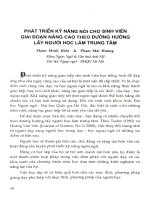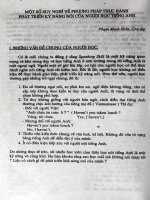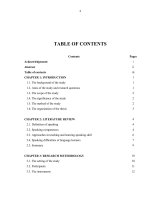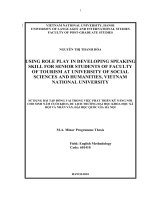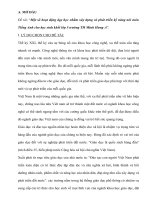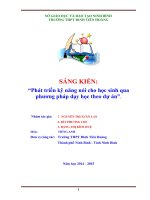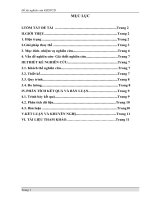0079 using storytelling to develop speaking skills for young learners at an english center in quy nhon sử dụng kể chuyện để phát triển kỹ năng nói cho học
Bạn đang xem bản rút gọn của tài liệu. Xem và tải ngay bản đầy đủ của tài liệu tại đây (455.61 KB, 79 trang )
MINISTRYOFEDUCATIONANDTRAINING
QUYNHONUNIVERSITY
PHANTHANHTHANG
USING STORYTELLINGTO
DEVELOPSPEAKING SKILLS FOR YOUNG
LEARNERS ATANENGLISHCENTERIN
QUYNHON
Field: Theory and Methodology of English Language
TeachingCode:8140111
Supervisor:Dr.VODUYDUC
BỘGIÁODỤC VÀĐÀOTẠO
TRƢỜNGĐẠIHỌCQUYNHƠN
PHAN THÀNHTHẮNG
SỬ DỤNG KỂ CHUYỆN ĐỂ PHÁT TRIỂN KỸ
NĂNGNÓICHOHỌCVIÊNNHỎTUỔITẠI
MỘTTRUNGTÂMTIẾNGANHỞ QUY NHƠN
Ngành:LýluậnvàphƣơngphápdạyhọcbộmônTiếngAnhMãsố :
8140111
Ngƣờihƣớngdẫn:TS.VÕDUYĐỨC
1
STATEMENTOFAUTHORSHIP
I certify that this thesis is the result of my own study and that it has
notbeensubmittedtoanyotheruniversityorinstitutionwhollyorpartially.Allstatements of the thesis which
are not my own are written in quotation andcanbe showninthelistof references.
Quy Nhon,2022
PHANTHANHTHANG
ACKNOWLEDGEMENT
Forthecompletionofthisthesis, Ihavereceivedgreatassistanceand s
upportfrommyteachers,colleagues,students and myfamily.
Firstofall, Iwouldliketosendmy deepestthankstomy
supervisor,Dr.VoDuyDuc,forhisencouragement,guidanceandhiscriticalcomm
ents,withoutwhichIcouldnothavefinishedmythesis.Healsoofferedmegreathe
lpintermsof ideasandmaterials.
I am also grateful to all lecturers of M.A course at the Department
ofForeign Languages and the Department of Pedagogy in specific and to
QuyNhonUniversity for their valuable lecturesfrom whichI have hadsucha great
motivation andbenefited alot in thewriting ofthis thesis.
Mysincerethanksareduetoallthecolleagues,andstudentsatInternational
Active Learning Center (IALC)- a n E n g l i s h C e n t e r i n Q u y Nhon
fortheircooperation in giving mevaluableinformation.
Last but not least, I am in debt to my beloved family and my wife whoare
always by my side with their constanth e l p a n d s p i r i t u a l s u p p o r t
d u r i n g mystudyingprocess.
I have made great efforts to complete the study. However, I realize
thatthis thesis is far from being perfect. To make it better, the author expects
anyconstructive criticism. At last, the writer hopes that this research paper will
beusefulforall.
ABSTRACT
In teaching a language, applying suitable method plays an importantrole
in the success of the lesson. Using stories for educational purposes is
aneffective teaching strategy especially for teaching young learners. This
studyaimed at investigating the use of storytelling technique in teaching
speaking atIALC - an English Center from teachers‟ perception and the difficulties theyface.The researcher
used qualitative and quantitative research which usedsurvey questionnaire,
interview and observation as instruments. The studyfindings showed that
teachers have vague understanding about the storytellingtechniqueandinfrequent use
of this techniquei n t h e i r t e a c h i n g . I n a d d i t i o n , all of them say
that this technique has many benefits to students and it canmake students happy
and easy to understand the lessons. Finally, all of theteachers find that this
technique
is
difficult
to
use,
needs
time
and
places
to
beappliedandcausesnoise.Itisrecommendedthatteachersneedf u r t h e r training on
the use of this technique because it is an important and effectivetechnique to get
students memorize the lesson and it also attracts students'attention,andit
improvestheirpredictionskills.
TABLEOFCONTENTS
STATEMENTOF AUTHORSHIP.....................................................................i
ABSTRACT.....................................................................................................iii
TABLEOF CONTENTS..................................................................................iv
LISTOF TABLES...........................................................................................vii
LISTOF FIGURES.........................................................................................viii
CHAPTER1. INTRODUCTION.......................................................................1
1.2. Rationale...............................................................................................1
1.3. Aims of the Study.................................................................................2
1.4. Researchquestions.................................................................................2
1.5. Scopeofthe study...................................................................................3
1.6. Significanceofthe Study........................................................................3
1.7. Organization ofthe study.......................................................................3
CHAPTER2. LITERATUREREVIEW.............................................................5
2.1. Speaking..............................................................................................5
2.1.1. Definitionsof speakingskill............................................................5
2.1.2. Speaking teachingtechniques.........................................................6
2.1.3. Techniquestoteach speakingskillto younglearners.........................7
2.2. Storytelling..........................................................................................8
2.2.1. Definition Storytelling...................................................................8
2.2.2. TheAdvantagesStorytelling...........................................................9
2.2.3. Storytelling Techniques...............................................................10
2.2.4. ProceduresTeachingSpeakingwithStorytellingTechnique............12
2.3. Difficulties ApplyingStorytellingTechnique.....................................13
2.4. Previous Studies.................................................................................15
2.5. Summary............................................................................................19
CHAPTER3.RESEARCHDESIGNANDMETHODOLOGY..........................20
3.1. ResearchDesign..................................................................................20
3.2. ContextOfTheResearch......................................................................21
3.3. Participants.........................................................................................23
3.4. Materials.............................................................................................23
3.5. ResearchInstrument............................................................................23
3.5.1. SurveyQuestionnaire....................................................................24
3.5.2. Interview.....................................................................................24
3.5.3. Observation.................................................................................26
3.6. DataCollection....................................................................................26
3.7. DataAnalysis.......................................................................................27
3.7.1. TheQuestionnaireDataAnalysisProcedures...................................28
3.7.2. InterviewDataAnalysisProcedures...............................................28
3.7.3. ObservationDataAnalysisProcedures...........................................29
3.8.
Summary.........................................................................................29
CHAPTER4.FINDINGSANDDISCUSSION.................................................30
4.1. Questionnaire.....................................................................................30
4.1.1. Teachers‟opinionaboutspeakingskills...........................................30
4.1.2. Teachers‟ perception
abouttheuseofcommunicativeactivitiesinteachingspeakingskills
31
4.1.3. Thefrequencyo f usingstorytellingactivitiesinteachingspeaking
32
4.1.4. Teachers‟roleindesigninga n d m a n a g i n g s t o r y t e l l i n g
activitiesinclassrooms............................................................................33
4.1.5. Teachers‟implementationofstorytellingactivities.............................34
4.1.6. Benefitsofu s e
s t o r y t e l l i n g activitiesinteachingEnglishspeakingskilltoyounglear
ner
35
4.1.7. Difficulties the teachers
encounterwhenconductingstorytellingactivitiesinteachingspeakingskills
36
4.2. Interview.............................................................................................38
4.2.1. Teachers‟understandingandpracticingstorytellingtechnique.384.2.2.
Storytellingisbeneficial...........................................................................39
4.2.3.Teachers‟ChallengesofUsingStorytelling........................................41
4.3. Observation........................................................................................43
4.4ChapterSummary..................................................................................46
CHAPTER5.CONCLUSIONANDSUGGESTIONS.......................................47
5.1. Conclusion..........................................................................................47
5.1.1. Theteachers‟perceptionsofstorytellinginaspeakingclass.................47
5.1.2The challenges teachersface
inusingstorytellingtoenhancestudentsspeakingskill..............................48
5.2. Implications........................................................................................49
5.3. Limitation...........................................................................................50
5.4. SuggestionsforFurtherStudies.............................................................50
REFERENCES................................................................................................52
APPENDICES
LISTOFTABLES
Table1:Rolesoftheteacherduringstorytellingactivities.......................................33
Table2:Teachers‟perceptionoftheaimsofstorytellingactivities............................34
Table3:Teachers‟waystopromotestorytellingactivities.......................................35
LISTOFFIGURES
Figure4.1.1:Teachers‟opinionaboutthespeakingskill..........................................30
Figure4.1.2:Teachers‟opinionaboutteachingspeakingskills................................31
Figure4.1.3:Teachers‟perceptionaboutt h e u s e o f c o m m u n i c a t i v e ac
tivities........................................................................................31
Figure4.1.4:Thefrequencyofusingstorytellingactivitiesteachersi n teachingspe
aking..........................................................................................32
Figure4.1.5:Teachers‟o p i n i o n s a b o u t t h e b e n e f i t s o f s t o r y t e l
l i n g activities..........................................................................36
Figure4.1.6:Teachers‟difficultiesinimplementingstorytellingactivities.................37
1
CHAPTER1.INTRODUCTION
1.2. Rationale
ThemasteryofspeakingskillsinEnglishisapriorityf
ormanysecondor foreign language learners and teaching speaking in language classes
playsan important role. When teaching speaking, teachers
learn that there are manychallengestocreatingagoodspeakingclass.Teachersshould
thinkaboutwhether or not the way they teach speaking is good.
Biyem (1997) says thatteachers have a lot of problems when
it
comes
to
teaching
and
learning
theEnglishlanguage.Forexample,therearenotenoughclassroom
sandeducational technology. Moreover Punthumasen (2007)
also
found
that
moststudentsdonotwanttolearnEnglishbecausetheyfinditbo
ringandthewayit is taught is not interesting. Also, there aren't enough interesting
Englishtextbooks andothermaterialstoget themtostudy.
When teaching English as a foreign language (EFL), a
teacher should setupaclassroomwherestudentscanhavereal-lifeconversations,doreallifeactivities, and do meaningful tasks that help them use oral
language.
Nunan(1991)saysthatteachersshouldhelptheirstudentsby
comingupwithwaystohandleallkindsofcommunication.Thiswillmakesurethatall
students getthe same chances to improve their speaking and listening skills with otherpeople.
The lessons will be more fun if the teachers can come up
with
funactivitiesbyusingtechniques
that
arerightforthelevelofthestudents.
These reasons support the idea that language teachers at all
levels
in
IALCEnglishCenterinQuyNhonshouldusemoreinterestingacti
vities,technology,orappropriatemethods
toimprovetheirteaching.
2
One way
to teach young
children
English is to
use
different
methods,such
as
language
games, songs,
role-playing,
storytelling,
etc.
The
techniqueoft e l
lingstories
hasbeenuse
dalotinedu
cation,andi
thashelpedt
each
language speaking in many ways. Many researchers around the world
(Nunan1988; Brimful et al. 1991; Ellis and Brewster 1991; Wood 1998;
Brewster etal. 2004; Write 2004; and others) suggest that storytelling is a good
andeffectiveway to improveyoung learners' skillsand interest inE n g l i s h
a n d helpthemlearnmore.
In conclusion, the purpose of this study is to find out more about
howteachers see and understand the role of stories in teaching English to
YoungLearners. The other goal of this study is to find out how teachers feel
aboutusing storytelling to teach young students in the classroom. The
researcherhopes that the results of this study will give teachers both theoretical
and real-worldreasonstousestoriestoteachyoungstudentsintheclassroom.Moreover,
this research was also conducted to solve the teachers‟ problems inteaching
speakingthrough storytelling.
Teachers at the IALC English Center in Quy Nhon have been using
thismethod, but it hasn't worked as well as they hoped. Lessons that teach how
totell stories aren't part of the curriculum, so they're always taught after
school.There's always not enough time, classrooms, teaching tools, etc. Because
ofthis, students don't get many chances to practice speaking in a
storytellingclassroom,so their speaking skillsdonotget muchbetter.
1.3. AimsoftheStudy
The study aims at examining objectives in their speaking classes
andinvestigating what problems teachers have when using storytelling to
teachspeaking.
1.4. Researchquestions
Basedo n t h e o b j e c t i v e s s t a t e d a b o v e , t h e s t u d y a i m s t o a n s w e r t
h e followingresearchquestions:
1. Whatareteachers‟perceptionsofstorytellinginaspeakingclass?
2. Whatarechallengesteachersfacei n usingstorytellingtoenha
ncestudentsspeakingskill?
1.5. Scopeofthestudy
The study was conducted at IALC – an English center in Quy Nhon.The
research concentrates on the young learners. The participants involved inthe
research are students at IALC. This research was conducted at IALC –
anEnglish center in Quy Nhon because this English center uses storytelling as
amethod to teach speaking skills to young learners. Therefore, the
researcherwanted to examine the teachers‟ perceptions of storytelling to teach
younglearners in classroom and solve the teachers‟ problems in teaching
speakingthrough storytelling.
1.6. SignificanceoftheStudy
ThisstudyattemptstodescribetheteachingofEnglishtoyounglearners through using
storytellinginspeakingclass at IALC–anEnglishcenter in Quy Nhon. The findings of the study
contributed a number of strongpoints to the center‟s head-office, English
teachers and researchers of therelated fields.
The study wasalso significantfor the teachers.Itwase x p e c t e d
t h a t theEnglishteacherscouldhavedeeperunderstandingaboutthetechniqueandtheeffectivenessofusingstorytellingandthey
wouldknowwhattheyneedsupporting. It means that the result of the study can be used as
a feedback bytheteacher toimprove theirteaching.
Finally,thestudycouldgivecontributiontootherresearchersasreferences
inconductingfurtherresearcher.
1.7. Organizationofthestudy
Thisminorthesisisdividedintofivechapters:
CHAPTER1:“ Introduction”p r e s e n t s r a t i o n a l e , s t a t e m e
ntofthe
problem, aims and objectives of the study, research question, the scope of
thestudy,significanceofthestudy,and the design ofthestudy.
CHAPTER 2: “Literature Review” provides a literature review
ontheoretical issues relatedto speaking andstorytelling.
CHAPTER 3:“ Methodology” describes an overview on context
ofthestudy,research design,instrumentusedinthestudy.
CHAPTER4:“Dataanalysisanddiscussion”resultsfromtheinvestigationo
fthefactualsituationinteachings p e a k i n g a p p l y i n g storytelling
techniqueatIALC –an EnglishcenterinQuyNhon.
CHAPTER5:“Conclusion”providesasummaryofthethesis'accomplishme
ntsandrecommendationstoeducationm a n a g e m e n t , instructors,andfuture
scholars.
CHAPTER2.LITERATUREREVIEW
In this chapter, the role of speaking is presented and speaking
teachingtechniques and storytelling technique. Toward the end of the chapter,
thedifficulties inapplyingstorytellingaregiven.
2.1. Speaking
2.1.1. Definitionsofspeakingskill
Accordingtoseveraleducatorsandscholars, communicationisa vital ability for
everyday
living.
Bailey
and
Savage
(1994)
underline
thatspeakingi s a f u n d a m e n t a l a b i l i t y t h a t i s t h e r e s u l t o f r e a d i n g a n d l i s t e
n i n g , and
that
it
is
used
daily.
In
a
similar
vein,
Hayride
(2006)
asserts
that
speakingisacriticalcomponentoflanguageacquisitionsincethecapacitytocommunicate
iscrucial tostudents'academicandprofessionalsuccess.
Nunan
argues
that
speaking
is
equated
with
oral
communication,whichare typicalmeans ofconveying information, expressing
ideas,
andarticulatingthoughtsNunan(1991).Accordingtothisperspective,iti s evident
that speaking is the act of delivering speeches and discussions toexpress one's
views. In addition, according to Chaney's definition, speaking isthe act of
constructing and communicating meaning via the use of verbal andnonverbal
symbols in a variety of circumstances Chaney (1988). From thisperspective,
body language can only be used to clearly convey emotion andopinion
whilespeaking.
In summary, most of these show some common characteristics
whichspeakingusesthewordsandproducesthesoundtoexpresstheirideas,feeling,thoughtt
hroughordinaryvoice.Moreover,speakingneedsverbalandnonverbalsymbolstoexpressspeakers‟knowledge,opinionincommunication.
Asresult,speakersneedtocombinevariousskillsinspeaking.
2.1.2. Speakingteachingtechniques
Speakingistheprocessthroughwhichindividualsexpressandtransmit their
thoughts to others verbally. Speaking, according to Girt andHans in Ferial
(2012), is speech or utterances made by the speaker with theaim of being
known, and then the listener analyzes the sayings to determinethe speaker's
intention. Speaking, according to Irawati (2014), is the action ofproducing
sayings in the form of wordsand phrases verbally in order tointeract with others.
Khorashadyzadeh
(2014),
on
the
other
hand,
says
thatspeakingr e q u i r e s n o t o n l y a n u n d e r s t a n d i n g o f h o w t o u s e l i n g u i s t
i c s k i l l s like
grammar,
pronunciation,
and
vocabulary,
but
also
an
understanding
ofsociolinguisticskillslikewhen,why,andhowtospeak.BahadorfarandOmidvar(2015),say
thataperson'sspeakingskillsaregoodwhenthelistenercanunderstandwhatthepersonissaying.
Also,
Ur
in
Akhyak
and
Indramawan
(2013:20)
say
that
speakingactivities that go well have a few things in common. First, the people
learningthe language want to talk as much as they can. Second, everyone who
takespart in the speaking activity gets a chance to talk. Third, the people
learningthe language are very motivated and interested in speaking. Finally, the
leveloflanguage usedisgoodenough.
Speaking
is
the
way
that
humans
share
and
talk
about
information,ideas, and feelings through spoken language. The goal of speaking
is for thespeaker and the listener to talk back and forth with each other. Both
theprofessorsandthestudentshopethatthestudentswillbeabletos p e a k Englishfluentlyin
class and in the real world. Teaching speaking is whatteachersdo to help their studentsget
betteratexpressing theirthoughts,feelings,andideasoutloud.
Speaking
is
the
way
that
humans
share
and
talk
about
information,ideas, and feelings through spoken language. The goal of speaking
is for thespeakerand thelistenertotalkbackand forthwith eachother.
Both the professors and the students hope that the students will be able tospeak
English fluently in class and in the real world. Teaching speaking iswhat
teachers
do
to
help
their
students
get
better
at
expressing
their
thoughts,feelings,andideasoutloud.
Students can improve their speaking skills in many ways, such as
bypracticing dialogues, playing games, singing songs, telling stories, giving
oralreports,roleplaying,havingsmallgroupdiscussions,givings p e e c h e s , readi
ng
the
news,
reading
poetry,
and
debating.
Young
people
can
improvetheirspeakingskills bylistening toand tellingstories.
2.1.3. Techniquesto teachspeakingskilltoyounglearners
Nunan (1991) recommends that learners would be better if they
aregiven the maximum number of chances to practice the target language
inmeaningfulsituations.Moreover,Nunan(2003)hasprovidedsomesuggestions
forteachingspeakingasbelow:
Teachers must first arrange their lessons with consideration for
thecontext variations between two languages and two cultures. He says
thatpupils struggle to acquire a foreign language in a variety of
circumstancesbecausetheyhavelimitedopportunitytoapplyitoutsidetheclassroom.
Therefore,somelearnersofaforeignlanguageareunabletocomprehendorconverse with native speakers in
real life.Secondly,attheearlyandintermediate levels, it is essential to build
fluency and precision. Teachersshould give pupils with opportunities to
improve their fluency. It is certainlytrue that committing errors is a normal part
of learning a new language, yetaccuracyisalsothe goaloftheprocess.
Thirdly, using group or pair work enhances the effectiveness of
thespeaking lesson. Activities including pair and group work may improve
theamount of time students speak the target language. In addition, there
areadditionalopportunitiesforstudentstosharespeaking-relevantinformation.
Next,teachersshoulddesignspeakingactivitiesthatrequirenegotiation
meaning
via
clarification,
repetition,
or
of
explanation
requests.Teachersshoulddesignspeaking activitiesthatareappropriatefo
ralllevels ofstudentsintheclassroomin order to assesstheirabilities.
Finally,
teachers
should
construct
classroom
activities
that
provideinstruction and practice in both transactional speaking (communicating
tocomplete a task, such as the trade of products) and interactional
speaking(communicatingtoengage withothers).
2.2. Storytelling
2.2.1. DefinitionStorytelling
Before going to bed, the majority of kids look forward to
hearingbedtime stories from their grandparents or parents. This was back in the
daysbefore the development of television, computers, or the internet. According
toRubin(1990),storytellingisthe"oralinterpretationofliteratureandfolklore."Thisdefinitionindicatesthatthenarrative,thestoryteller,the
place, and thelisteners are the elements that make up the medium of storytelling.
AccordingtoHarari,the
difference
between
humansandanimalsisthat
peoplearecapable of creating tales that are rich in both imagination and
experienceHarari (2014). It is the way that has been used by people throughout
theirhistoryandiscompletelynaturaltopassontheirknowledgefromonegeneration
tothe next.
In today's world, writers use a wide range of linguistic devices
toarticulatetheirunderstandingofthe term"storytelling."
According to Safdarian (2013), students are considered to be engaging
instorytelling when they repeat tales in their native tongue after listening to
thestoriestoldby
theinstructor.Inadifferentsense,storytellingisano r a l activity
that involves improvisation in the telling of a story, facial gestures,and body
movement. This type of storytelling is used to grab the attention
ofaudiencesbyutilizingmultisensorytechniquesthatstirtheemotionassociatedwithaneventinastoryStanleyandD
illingham(2009).I n addition,Champion,whoisreferencedinIrawati(2003),elucida
testhatstorytelling is an oral activity in which words and gestures may be
employedin a colorful manner to construct scenes in a sequence. This idea is
presentedinthe contextof storytelling.
All of the information shown up to this point suggests that tellingstories
orally
involves
arranging
imaginative
situations
in
a
progression
thatstimulateschildren'simaginations,helpsthemacquirelanguages,andmotivatest
hem.
2.2.2. TheAdvantages Storytelling
According to the findings of a large number of academics,
tellingtaleshasavarietyofbenefits,includingthoserelatedtolanguagedevelopment,
creativity,
and
motivation.
The
importance
of
storytelling
in
thedevelopmentofone'simaginationisemphasizedbyEllisandB r e w s t e r (2002).
Children get more emotionally invested in a narrative when they areable to
recognize
themselves
in
the
artwork
and
characters.
Their
creativeabilityisenhancedbytheexperienceofusingtheirimagination.Storyt
ellingis another effective method for connecting a child's actual environment withhis or her fantasies and
imagination.
According
to
Hayriye
(2006),
creatingstoriesallowsstudentstoconveytheirthoughtsfreelyandimaginativelywithout
havingtoworryaboutwhetherornottheyhavereachedtheappropriateconclusion.


